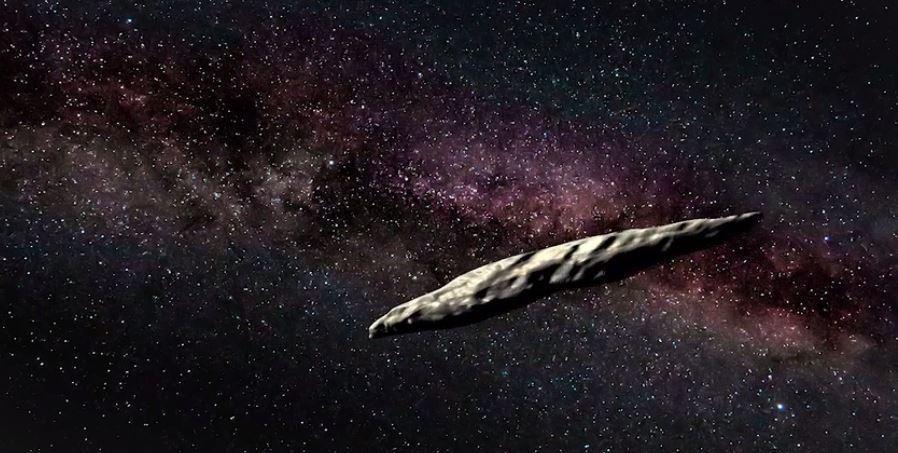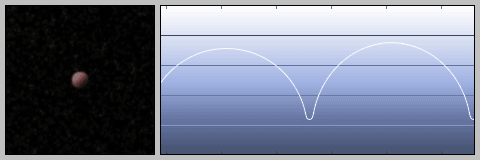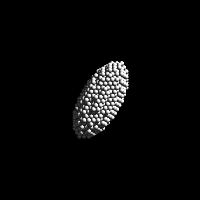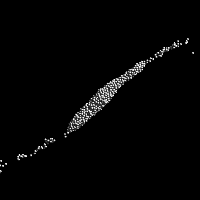Oumuamua: a fragment of a tide-shattered comet
The discovery of the first interstellar object at the end of 2017 immediately set theoretical problems for science. The open celestial body looked a little different from what the theory predicted.

First, it was supposed that it should be a comet in 99-99.9% of cases. Secondly, such an elongated form still occurs less frequently among bodies of similar size in the Solar System. The elongated shape can, if desired, be attributed to the effect of observational selection. A spherical body of the same mass would have a smaller surface area, and therefore a lower brightness than an extended body at the maximum (when turned sideways). For Oumuamua, the difference between the “average” brightness and the maximum reaches 1 magnitude, that is, 2.5 times.

Given that the object was found at the limit of the sensitivity of the tools, this is quite enough so that similar objects, but more rounded, are simply lost.
However, the absence of cometary activity is not so simple. The mechanism of formation of the Oort Cloud, which contains predominantly comets and interstellar small bodies, should be approximately the same - the release of emerging planetary systems under the influence of gravitational perturbations from growing and migrating protoplanets. There can be no other effective way. At the same time, objects of the Oort Cloud, which after billions of years we observe as comets, “get stuck” in the vicinity of a star at a great distance (of the order of a light year). Interstellar small bodies should consist of objects that were lost by some Oort Cloud or could not “fix” in it and were finally thrown out not only beyond their “native” planetary system, but also beyond the “native” cluster of stars formed. From this, it would seem, that objects from the Oort Cloud should look exactly the same as interstellar objects. The conditions for “storing” objects of the Oort Cloud (radiation, etc.) are no different from those for small bodies that freely surf the galaxy.
')
In haste, some scholars have proposed a whole range of explanations for the varying degrees of Britishness . Examples:
- Progenitors of Oumuamua-type objects are red giants stars
- The progenitors of Oumuamua-type objects are white dwarf stars
- Promotion and stretching under the influence of interstellar "wind"
- Oumuamua - an asteroid originating from a binary star system
- etc. etc...
Without going into details, it is possible to state responsibly that all the options proposed before this do not stand up to scrutiny. In short, the points:
- Exotic types of stars (red giants, white dwarfs, and at least black holes) cannot give typical small bodies of the interstellar medium due to their low abundance.
- Neither galactic cosmic rays nor the interstellar medium can be any explanation, since the conditions in our Oort Cloud are exactly the same as those of a purely interstellar medium, since the removal of Oort Cloud objects from the Sun is very large (about a light year).
- Assuming "asteroid" origin for most interstellar small bodies also fails, since the bulk of small bodies and planets form behind the so-called "snow line" around stars. This is fully confirmed by the existing statistics on observed exoplanets and protoplanetary disks.
However, on March 9, another article appeared in free access, on which I would like to dwell in more detail: Interstellar object 'cometary planetesimal . The authors offer the first, so far more or less consistent explanation of the properties of Oumuamua, which follow fairly straightforwardly from the laws of celestial mechanics, and are not far-fetched.
Imagine a protoplanetary disk filled with small bodies and emerging giant planets. In order for a small body to travel on its star cluster or galaxy, it must experience a rapprochement with the giant planet for exchanging momentum and changing speed. The closer the approach to the giant planet occurs, the greater the perturbation (impulse exchange) will be and the higher the average speed of a small body will be at “ejection” from the disk. But there is also the limit of Roche . Having become very close to the giant planet, small bodies experience tidal destruction, which should look like this:
 |  |
Tidal destruction itself may be responsible for the elongated shape of the fragments and is one of the probable causes of the elongated shape. Therefore, the authors suggest that Oumuamua is a fragment of a former comet that was destroyed as it approached the giant planet. But this is not the only reason. According to the simulation, up to 1% of small bodies ejected from planetary systems into interstellar space should be fragments as a result of tidal destruction. Each destroyed comet generates many fragments, the number of which may exceed the number of comets ejected entirely. The difference with objects from the Oort Cloud may be that it is populated predominantly by “whole” objects ejected at lower speeds (more “gently”, without tidal destruction).
To explain the lack of sublimation of Oumuamua, the authors suggest the subsequent convergence of comet fragments with a star. However, in my opinion, this is not required. Obviously, the overwhelming majority of small bodies are ejected in the first millions of years, when the planetary system is formed and migrations occur. At this time, the giant planets are still hot, look like brown / red dwarfs, the surface temperature is usually around 2000 K. This should lead to the disappearance of volatile substances from small bodies that are too close. At the same time, in full accordance with celestial mechanics, bodies approaching closer to giant planets will acquire higher velocities at infinity.
An infographic has already appeared in the media, illustrating a new hypothesis about the origin of Oumuamua:

Source: https://habr.com/ru/post/374329/
All Articles